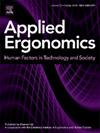A comparison of vibrotactile patterns in an early warning system for obstacle detection using a haptic vest
IF 3.1
2区 工程技术
Q2 ENGINEERING, INDUSTRIAL
引用次数: 0
Abstract
Technical devices can enhance safety by warning people of unrecognized obstacles, particularly in traffic, wilderness, and industrial settings. This study aims to identify the most effective vibrotactile stimuli for localization tasks by developing and evaluating various types of vibrotactile alerts presented through a tactile vest with visual patterns. The study design involved comparing the time and consistency of interpreting visual stimuli and subsequent tactile stimuli. The tactile stimuli included: a ’point’ vibration on the left or right side of the back, a ’column’ pattern of five vibrations on one side of the back, and a ’wave’ pattern of vibrations running along the back from left to right or vice versa. The results indicated that reaction times to visual stimuli were significantly shorter than to vibration stimuli, suggesting that visual stimuli are suitable for alert systems with low cognitive load. The ’point’ and ’column’ patterns were recognized significantly faster and more clearly than the’wave’ pattern. Consequently, the haptic vest was classified as a potentially effective low cognitive load device in localization performance. The findings could inform the design of early warning systems for obstacle detection in real traffic situations.
使用触觉背心的障碍物探测预警系统中振动触觉模式的比较。
技术设备可以通过警告人们注意未识别的障碍物来提高安全性,尤其是在交通、野外和工业环境中。本研究旨在通过开发和评估通过带有视觉图案的触觉背心呈现的各种类型的振动触觉警报,确定对定位任务最有效的振动触觉刺激。研究设计包括比较解读视觉刺激和后续触觉刺激的时间和一致性。触觉刺激包括:背部左侧或右侧的 "点 "状振动、背部一侧五次振动的 "柱 "状图案,以及沿背部从左到右或从右到左的 "波 "状图案。结果表明,对视觉刺激的反应时间明显短于对振动刺激的反应时间,这表明视觉刺激适用于认知负荷较低的警报系统。对 "点 "和 "柱 "图案的识别速度和清晰度明显高于 "波 "图案。因此,在定位性能方面,触觉背心被归类为一种潜在有效的低认知负荷设备。这些研究结果可为在实际交通环境中设计障碍物探测预警系统提供参考。
本文章由计算机程序翻译,如有差异,请以英文原文为准。
求助全文
约1分钟内获得全文
求助全文
来源期刊

Applied Ergonomics
工程技术-工程:工业
CiteScore
7.50
自引率
9.40%
发文量
248
审稿时长
53 days
期刊介绍:
Applied Ergonomics is aimed at ergonomists and all those interested in applying ergonomics/human factors in the design, planning and management of technical and social systems at work or leisure. Readership is truly international with subscribers in over 50 countries. Professionals for whom Applied Ergonomics is of interest include: ergonomists, designers, industrial engineers, health and safety specialists, systems engineers, design engineers, organizational psychologists, occupational health specialists and human-computer interaction specialists.
 求助内容:
求助内容: 应助结果提醒方式:
应助结果提醒方式:


